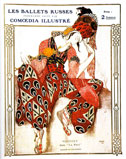|
From its legendary first performances in May 1909 at the Theatre du Chatelet, the
Ballets Russes did more for Parisian audiences than just present them with new choreography, new music,
new stars, and a new performing company. These productions redefined ballet for the twentieth century,
reinventing an entire art form that had grown stale elsewhere in Europe. At Russia's Imperial theaters
and ballet school, the traditions of ballet, rooted in the court dances of Louis XIV's reign and Italian
pantomime were not only preserved, but nurtured and developed further. With extensive financial support
from the Tsar's coffers, few corners were cut in the training of dancers, the hiring of choreographic and
performing talent, and the staging of productions. It was in St. Petersburg that all of Diaghilev's great
choreographers, and many of his star and corps de ballet dancers were trained. Fokin, Nijinsky, Massine,
Nijinska, and Balanchine were all the products of the Imperial Ballet School, and began their dance careers
at the Mariinsky theater, as did Karsavina, Pavlova, Danilova, Lopokova and countless others.
The first Ballets Russes ballet actually premiered in Russia and had nothing at all to do
with Diaghilev. Pavillon d'Armide was the brainchild of the artist, critic and historian Alexandre Benois,
an avid balletomane whose grandfather had built the Mariinsky Theater. Benois wrote the libretto of the ballet
in 1903 and Nikolai Tcherepnin composed the music to suit the plot, in close consultation with Benois. The ballet
was bought by the Mariinsky, but left unstaged until Mikhail Fokin, a brilliant young choreographer and
balletmeister there came across it, staging a segment of it as a graduation performance for the students of the
Imperial Ballet School. The success of this performance led to renewed interest in the ballet for the Mariinsky's
main stage, and in 1907 Fokin and Benois staged the ballet together, with sets and costumes designed by Alexandre.
A scholar of not only art but dance history, Benois worked throughout with Fokin on the stage direction and even
choreography of the piece, especially the numbers involving large groups of dancers. Benois' great friend, Diaghilev
was present at the opening and was conquered by the performance, finally agreeing with Benois' advice that he should
bring not only opera but ballet productions to Paris. Le Pavillon d'Armide demonstrated both Fokin's innovative approach
to choreography, and Benois' ideas about collaborative creation in the theater, where he felt directors, designers,
composers and performers should work together as one, to achieve aesthetic unity. All this would become the foundation
of the Ballets Russes as a company, and would ensure its Parisian success.
The Ballets Russes' twenty-year existence can be broken up into
approximate choreographic periods. 1909-1914 was the Fokin era, and it was he who
not only created most of the company's ballets, but also maintained the troupe as
balletmeister. Fokin's seminal choreographic works, performed frequently to this day,
include Les Sylphides, Scheherezade, Firebird, Petrushka, and Spectre de la Rose.
He also created numerous other productions that are less well known today because the
complexities of their staging and the lack of preserved choreography make them difficult
to put on, among them are Pavillon d'Armide, Daphnis et Chloe, and Le Coq d'Or.
A student of Fokin's from the Imperial Ballet School and star of many of his choreographic
compositions, Vaslav Nijinsky, eventually became Diaghilev's choreographic protege.
However, he managed to create just three ballets before his 1913 marriage nearly ended
his career. Insanely jealous, Diaghilev fired Nijinsky, and re-hired him only briefly
in 1916 when Nijinsky danced in the Ballets' North American tour and created one last
ballet, Till Eulenspiegel. Although his work as a choreographer was brief, it was significant;
in Prelude a l'apresmidi d'un Faune, Le Sacre du Printemps and Jeux, Nijinsky departed even
further than Fokin from the traditional vocabulary of movement, progressing more in the
direction of modern dance than in the continuation of ballet tradition resumed by his
successor, Leonid Massine.
Principal choreographer as well as star dancer after the departure of
both Fokin and Nijinsky, Massine led the company from 1915 to 1921. Among his innovative
choreographic works of the period were Le Soleil de Nuit, La Boutique Fantastique, and Le
Tricorne. When, after years as Diaghilev's lover, Massine declared his independence by
marrying and refusing to allow himself to be bullied by his sometimes overbearing boss,
he nevertheless remained tied to the Ballets Russes. From 1932 to 1937 he was the chief
choreographer of the Colonel de Basil Ballets Russes, a successor company, before leaving
with a group of discontented dancers to start his own troupe, the Ballet Russe de Monte Carlo.
In the de Basil Ballets, Massine had shared the spotlight with two former colleagues, Bronislava
Nijinska and George Balanchine. A brilliant dancer herself, though not so beloved as her elder
brother, Nijinska had worked for Diaghilev for over a decade when she finally got her chance
to be a choreographer in 1923. Among the pieces she created at the Ballets Russes were Les Noces,
Le Train Bleu, and Les Biches. Balanchine was her successor and the company's last major
choreographer. After a knee injury effectively ended his performing career in 1926, he concentrated
his energies on choreography and by Diaghilev's death in 1929 had created nine ballets, including
La Chatte, Apollon Musagete, Le Fils Prodigue and Le Bal. Many of these starred Diaghilev's latest
lover, Serge Lifar, who might well have become the next balletmeister if Diaghilev had not died soon
after Lifar's first efforts in choreography. Altogether, the choreographers and dancers of the Ballets
Russes overturned many of the static conventions of classical Ballet, and ushered in the era of modern
dance while preserving a sense of tradition and the heritage of the Russian ballet school.
|


Portrait of Serge Diaghilev
and his Nanny, by Leon
Bakst,
1906


Ballets Russes program,
with design for Nijinsky
in
La Peri by Leon Bakst,
1912
|